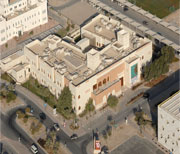Participants
The student project is only open to undergraduate design students within the GCC, Lebanon, Egypt, Jordan and Syria.
The designers of the top five entries will receive paid registration, economy class travel, and accommodations to attend ICOGRADA Design Week in Qatar 2009.
Single or group projects are encouraged. It is the responsibility of the group to decide on a representative should a group project be selected as a winning prize.
Exhibition
This exhibit will be held within Virginia Commonwealth University School of the Arts in Qatar, from February 28th, until March 5th, 2009. This exhibit will be part of the venue for ICOGRADA
Design Week in Qatar 2009, an international conference exploring collaboration. This will be an exhibit of selected submissions in order to establish a higher quality of design explorations as well as to keep the exhibit within a manageable and digestible number of features. The submission selection will also enable this exhibit to present a balance of conceptual and applied responses while including a diversity of design disciplines.
Student Design Project
Collaboration is a combined effort that results in the deepening of inter-relationships and shared knowledge. Design is now considered a team endeavor where collaboration is crucial to achieve innovative results that are inclusive of cultures and mediums. Designers are crossing boundaries, and have become part of creative interdisciplinary teams that address broader issues of communication, space, systems thinking, cultural identity, style, and business. Designers have become instrumental in working together to affect change on a global level.
Student Project:
Propose and present a concept for a community project that involves a collaborative, interdisciplinary design approach. Utilize the poster format, as described in the details, to explore and promote your concept for the project.
or
Present a community project involving a collaborative, interdisciplinary design approach that you have already participated in. Use the poster format to present the concept of the project as well as the outcomes that were achieved. Point of Inspiration: Black Mountain College, a collaboration of ideas and approaches Black Mountain College was an experimental college located near Asheville, North Carolina. The college was founded in the fall of 1933 by John Andrew Rice, Theodore Dreier and other faculty members who had been fired or resigned from Rollins College the previous spring. The college sought to educate the whole student - head, heart, and hand – through studies and the experience of living in a small community and performing manual work. It was experimental in nature and committed to an interdisciplinary approach.
The college attracted a faculty that included many leading visual artists, poets, and designers. In 1933, the college brought Josef Albers, artist and former Bauhaus teacher, and his wife Anni Albers, a Bauhaus-trained textile designer and weaver, to teach. With their arrival, the college became a unique center for the transmission of Bauhaus teaching and philosophy. Operating in a relatively isolated rural location with a limited budget, Black Mountain College had an informal and collaborative spirit and over its lifetime attracted a venerable roster of instructors. Some of the innovations, relationships and unexpected connections formed at Black Mountain would prove to have a lasting influence on the postwar art scene, high culture, and eventually, pop culture.
The presence of artists and scholars was critical to the learning experience at Black Mountain throughout its history. Buckminster Fuller met student Kenneth Snelson at Black Mountain, and the result was the first geodesic dome (improvised out of slats in the school’s back yard). Merce Cunningham formed his dance company, and John Cage staged his first happening. Not a haphazardly conceived venture, Black Mountain College was a consciously directed liberal arts school that grew out of the progressive education movement. In its day it was a unique educational experiment for the artists and writers who conducted it, and was an important incubator for the avant garde.
Details
All submissions must be received by January 15, 2009. Submissions should be sent by email to:
in the following format:
• PDF
• 300DPI (Dots per Inch)
• CMYK, 8 Bit Ready
• 594 x 841 mm(A1)
• Posters can be landscape or portrait format
For information please contact Leland Hill at [email protected]
Information on the next student competition will be available soon.



